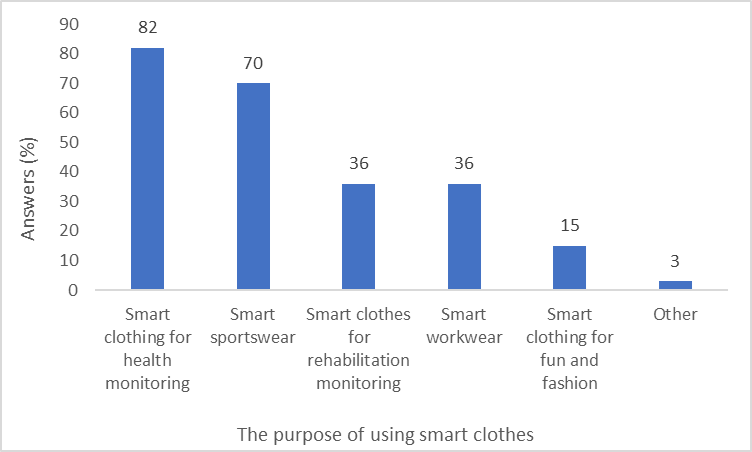Consumers’ knowledge and acceptance of smart clothing
DOI:
https://doi.org/10.25367/cdatp.2022.3.p90-96Abstract
To help innovative products breakthrough in the marketplace, it is necessary to gain consumer trust. However, consumers do not necessarily receive innovations positively and may have various concerns. Innovation involves change, and many consumers are reluctant to change or need more time to gain confidence in an innovative product, whether in terms of its usefulness, benefits, price, appearance, etc. Therefore, consumers’ lack of knowledge and acceptance of innovations may be one of the key reasons why many innovations fail to come to life in the market. Smart clothing, as a kind of wearable device that combines information and communication technologies and textile materials in a clothing system, has great potential for development and market breakthroughs today. In this study, we investigated the prevalence of smart wearable devices and smart clothing in terms of consumers' knowledge and acceptance of smart clothing by consumers. The results of the survey both serve as a guide for the development of the most desirable smart clothing and indicate the necessary communication strategies for its breakthrough in the market.
References
Ju, N.; Lee, K. H. Consumer resistance to innovation: smart clothing. Fash Text. 2020, 7, 21. DOI: 10.1186/s40691-020-00210-z.
Ju, N.; Lee, K.-H. Perceptions and Resistance to Accept Smart Clothing: Moderating Effect of Consumer Innovativeness. Appl. Sci. 2021, 11(7), 3211. DOI: 10.3390/app11073211
Fernández-Caramés; T.M., Fraga-Lamas, P. Towards the Internet of Smart Clothing: A Review on IoT Wearables and Garments for Creating Intelligent Connected E-Textiles. Electronics 2018, 7(12), 405. DOI: 10.3390/electronics7120405.
Thorp, E. O. The invention of the first wearable computer. In Proceedings of the Second International Symposium on Wearable Computers (Cat. No.98EX215), 1998, pp. 4-8, DOI: 10.1109/ISWC.1998.729523.
Thorp, E.O., Beat the Dealer, 2nd ed. Vintage: New York, NY, USA, 1966.
Shishoo, R., Textiles in Sport, 1st ed. Woodhead Publishing: Sawston/Cambridge, UK, 2005.
Gilsoo, C.; Seungsin, L; Jayoung, C., Review and Reappraisal of Smart Clothing. International Journal of Human-Computer Interaction 2009, 25(6), 582-617.
Al Mahmud, A.; Wickramarathne, T.I.; Kuys, B. Effects of smart garments on the well-being of athletes: a scoping review protocol. BMJ Open 2020, 10, e042127. DOI: 10.1136/bmjopen-2020-042127.
McCann, J.; Hurford, R.; Martin, A. A design process for the development of innovative smart clothing that addresses end-user needs from technical, functional, aesthetic and cultural view points. In Proceedings of the Ninth IEEE International Symposium on Wearable Computers (ISWC’05), Osaka, Japan, 18–21 October 2005.
Brown, D. The Arrival Of 2020 Brings Smart Clothing To The Forefront Of Healthcare YouAreUNLTD.com. http://www.youareunltd.com/2020/01/03/smart-clothing-at-the-forefront-of-a-new-frontier-in-healthcare/ (accessed 2022-04-21).
Jiang, S., Stange, O., Bätcke, F.O., Sultanova, S., Sabantina, L. Applications of Smart Clothing – a Brief Overview. Communications in Development and Assembling of Textile Products 2021, 2(2), 123-140. DOI: https://doi.org/10.25367/cdatp.2021.2.p123-140
Rudolf, A.; Stjepanovič, Z.; Penko, T. Review of smart clothing with emphasis on education and training. In Proceedings of the 7th International Symposium “Technical Textiles – Present and Future”. 12th November 2021, Iaşi, Romania. [Warsaw (Poland)]: Sciendo, pp. 219-226, 2022.
Ahsan, M.; Teay, S.H.; Sayem, A.S.M.; Albarbar, A. Smart Clothing Framework for Health Monitoring Applications. Signals 2022, 3(1), 113-145. DOI: https://doi.org/10.3390/signals3010009.
Smart Textiles Market to 2024. https://www.ameriresearch.com/product/smart-textiles-market/ (accessed 2022-04-21)
Nam, C.; Lee, YA. Validation of the wearable acceptability range scale for smart apparel. Fash. Text. 2020, 7, 13. DOI: 10.1186/s40691-019-0203-3
Talwar, S.; Talwar, M.; Kaur, P.; Dhir, A. Consumers’ Resistance to Digital Innovations: A Systematic Review and Framework Development. Australasian Marketing Journal 2020, 28(4), 286-299. DOI: 10.1016/j.ausmj.2020.06.014
Seth, H.; Talwar, S.; Bhatia, A.; Saxena, A.; Dhir, A. Consumer resistance and inertia of retail investors: development of the resistance adoption inertia continuance (RAIC) framework. J. Retail. Consum. Serv. 2020, 55, 102071. DOI: 10.1016/j.jretconser.2020.102071
Tansuhaj, P.; Gentry, J.W.; John, J.; Lee Manzer, L.; Cho, B.J. A Crossnational Examination of Innovation Resistance. Int. Mark. Rev. 1991, 8(3). DOI: 10.1108/02651339110000135.
Talke, K.; Heidenreich, S. How to overcome pro-change bias: incorporating passive and active innovation resistance in innovation decision models. J. Prod. Innov. Manag. 2014, 31(5), 894-907. DOI: 10.1111/jpim.12130.
OptimTex project Application form (2020), Erasmus+ KA2 – Strategic Partnership for Higher Education (Call 2020).
Rotzler, S.; Kallmayer, C.; Dils, C.; von Krshiwoblozki, M.; Bauer, U.; Schneider-Ramelow, M. Improving the washability of smart textiles: influence of different washing conditions on textile integrated conductor tracks. The Journal of the Textile Institute 2020, 111(12), 1766–1777. DOI: 10.1080/00405000.2020.1729056.
Rotzler, S., Krshiwoblozki, M. and Schneider-Ramelow, M. Washability of e-textiles: current testing practices and the need for standardization. Textile Research Journal 2021, 91(19-20), 2401-2417. DOI: 10.1177%2F0040517521996727.

Downloads
Published
How to Cite
Issue
Section
License
Copyright (c) 2022 Andreja Rudolf, Zoran Stjepanovič, Monika Kuharič

This work is licensed under a Creative Commons Attribution-NonCommercial-NoDerivatives 4.0 International License.





